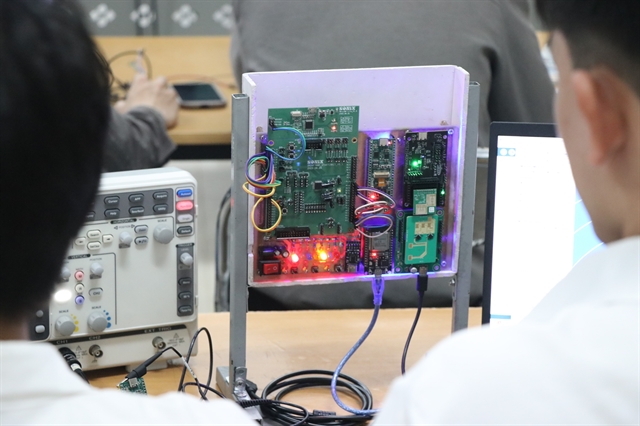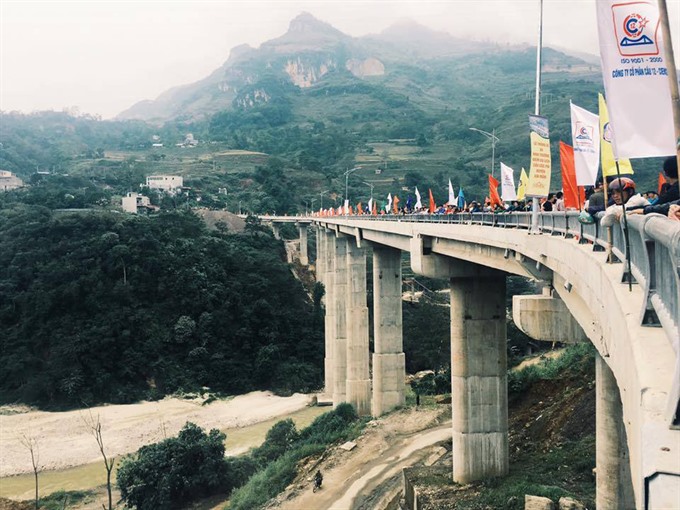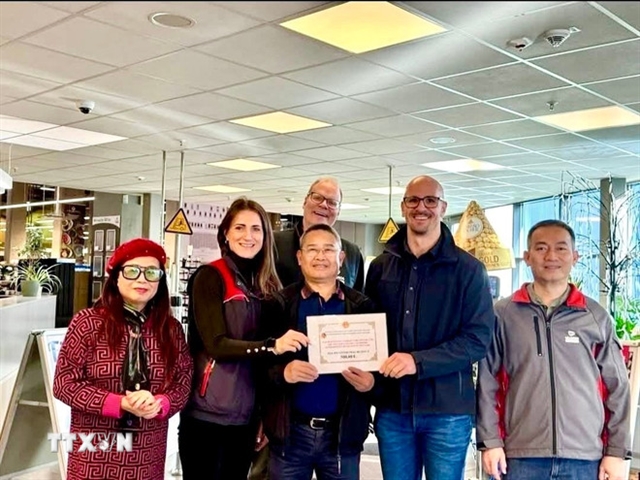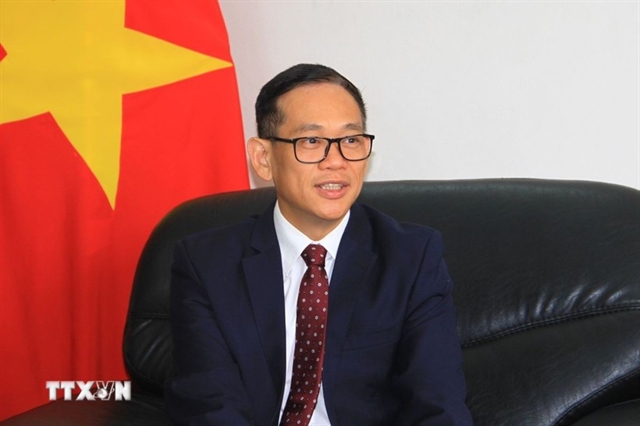 Society
Society

A new bridge in Hà Giang Province's Xín Mần District connects residents with a future that teems with development potential
 |
| The Cốc Pài Bridge in Hà Giang Province’s Xín Mần District officially opened to traffic last Sunday - VNS Photo Hồng Minh |
By Hồng Minh
HÀ GIANG – Teacher Nông Thị Vá is early riser.
She has no choice because her 12km daily commute to work involves driving her motorbike through rough mountain roads and crossing the local river on a small suspension bridge.
She has to do all this to get to a class of 12 Tày ethnic minority students in Thèn Phàng Commune, Ha Giang Province.
As someone belonging to an ethnic minority community (La Chi) herself, Vá knows how important education is for people like herself. It is a ticket out of poverty, so she does not want to miss a class or be late for one.
Last Sunday, life got much easier for Vá, 46, a resident of Cốc Pài Town in Hà Giang. A new bridge over the Chảy River opened to traffic that day.
“The old bridge was narrow and dangerous. On rainy days, it got really bad. I would have to wait for hours to get across,” Vá said.
The Cốc Pài Bridge on National Highway 4 connects Hà Giang and Lào Cai provinces, and is also a link between the mountainous Xín Mần District and its surrounding areas.
“I can reduce my travel time by more than half an hour,” Vá said, adding that this gave her some time in the morning for herself.
The bridge has put smiles on students’ faces too.
Mã Thị Thiện, a ninth-grader at the Xín Mần Boarding School, said she felt safe on the new bridge. The old one was especially dangerous during the flooding season, the Nùng girl said.
“In the past, my parents and other villagers of Xín Mần District had to carry their agriculture produce and handicraft products on their back or lead horses carrying the products for hours to the market” Thiện said.
“But now, with the Cốc Pài Bridge, it is much easier and faster. Vegetables and other agricultural produce get to the market still fresh, fetching higher prices.”
Hard work
The Cốc Pài Bridge is one of 76 planned under Phase 2 of a 2013-2020project that rehabilitates and rebuilds bridges on the national road networks. Up to144 national highway bridges were completed in Phase 1 of the project.
The Cốc Pài Bridge was built at a cost of nearly VNĐ160 billion (more than US$7 million), financed with a loan from the Japan International Co-operation Agency (JICA) and counterpart funds from the Vietnamese Government.
Phạm Ngọc Biên, Deputy General Director of Project Management Unit 6, under the Ministry of Transport (MoT), said the 9m wide, 337.28m long bridge was constructed with reinforced concrete using advanced technology.
“I still remember clearly that in February last year, when the first trucks carrying equipment and materials arrived at the construction site, we saw the obstacles posed by the complicated location and terrain.
“We had to take the roads from Lào Cai Province and transfer all materials to other trucks when it was 15km away from the site,” he said, adding that the harsh weather in Xín Mần District also slowed construction.
The bridge’s project manager, Ryoji Takeuchi of the Joint Venture KEI-OCG-TEDI, also spoke of the difficulties they faced, including “piling at the location of a steep hill slope and launching girders in deep, dangerous and narrow areas.
“It was very complicated,” he said.
He said that construction of the 65m pier, second tallest in northern Việt Nam, could be compared to building a skyscraper, with the deployment of helicopters and tower cranes.
“Our project has 50 bridges across Việt Nam, but this Cốc Pài Bridge has demanded maximum attention and care.”
Huge difference
Xín Mần District, a direct beneficiary of the Cốc Pài Bridge, is located 160km west of Hà Giang’s centre. It comprises 18 communes and a town. It is home to 16 ethnic minority communities, with the Tày and the Nùng constituting the majority.
Hoàng Nhị Sơn, Chairman of the District People’s Committee, said that it had a population of around 65,000, of which 62.2 per cent were listed as poor. This poverty had a lot to do with the difficult terrain of high slopes and scarce transportation means, he added.
Sơn saw the new bridge connecting the district with a great development potential for the local economy.
“This is a strong bridge and constructed at solid location to avoid landslides and flooding, so it is safe for people.
“Now heavy trucks can go on the bridge, carrying goods straight to the border gate with China and other neighbouring provinces; it will surely contribute to the district’s growth.
“I also see it as a very beautiful bridge at a scenic location, and it can attract more tourists to Xín Mần.”
Sơn said that in the first six months of the year, the number of tourists coming to Xín Mần was just 9,000. But since the bridge was built, even before its official opening, the number of visitors increased markedly to more than 11,000 in the last three months.
Fujita Yasuo, Chief Representative of JICA Việt Nam Office, said the bridge would contribute a lot to improving the lives of local residents because of better logistics, greater tourism opportunities and socio-economic development.
“Our official assistance to Việt Nam is not only for economic benefit but also for a better life for local people,” he said, adding that aim of projects in mountainous areas such as Xín Mần District is to narrow the gap between remote and developed areas.
Fujita said the new bridge would also enhance bilateral co-operation between Việt Nam and Japan.
“Japanese people mainly live in Hà Nội and HCM City and surrounding areas. Their access to areas like Xín Mần is very limited,” he said.
“With this bridge I think there will be more opportunities for local people to know about Japan while more Japanese people will be interested in Xín Mần District in particular and Hà Giang Province in general,” he added.
Teacher Vá said she had indeed seen more people coming to the district these days.
“We used to be quite remote before as the road here is not easy. I really hope the new bridge will remove people’s concerns about coming to Xín Mần,” she said.
“My students can easily get out of their villages and visit local towns. The bridge has opened a whole new world for them.” -- VNS




